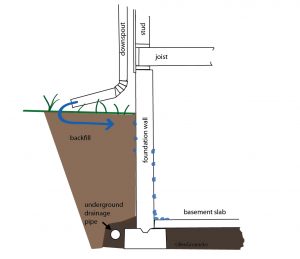The Importance of Downspout Extensions

I was doing a home inspection in Glenview when I informed my client about the lack of downspout extensions. The real estate agent spoke up and stated that the home inspector she uses doesn’t think that is a problem. I always thought that every home inspector calls out downspouts discharging too close to a house. Let’s ask the question; is that a big deal?” Yes, because of the damage it can cause, and no because it is such an easy and inexpensive fix. Home inspectors usually tell their clients to get the downspouts 4 to 6 feet away from the building. Here is why we say “4 to 6 feet”.
When houses are first built, a hole needs to be dug out and earth is removed. This is referred to as the over-dig for the foundation. The over-dig is the room needed for the construction workers to get the forms in and out so they can make the footings and foundations.
The footing is then poured and allowed to cure (harden). The foundation is then poured on top of that and eventually the basement floor is poured on top of the footing on the inside of the foundation wall. Since these three areas are not poured at one single time, there is a cold joint at this location. Waterproofing professionals refer to this area as the cove. Drain tile, stone, and the earth are installed on the outside of the foundation.
Here is the problem. The earth never goes back into the over-dig exactly the same way it came out. We end up with gaps, pockets of air, and avenues where water can easily travel down to the undisturbed earth that the foundation is sitting on. The water can then pool in this area and cause the earth to weaken. Weakened earth will cause settling. If the pooling water gets high enough, water then enters the basement. None of this is good.
If downspout extensions are used to get the water past the over-dig, 95% of the water will not enter the over-dig and pool up next to the foundation. So let’s install those extensions. Get the water 4 to 6 feet away from the house and greatly reduce the chances of settlement and water entry into the home.

Charles Bellefontaine CMI, CPI, ACI
May 6, 2018
Uncategorized
No Comment